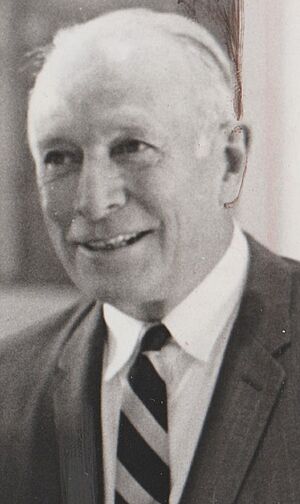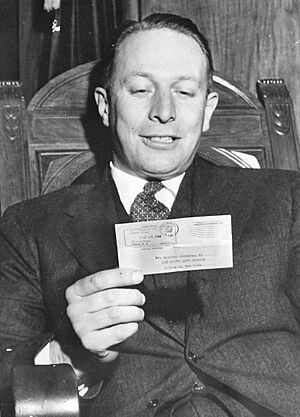Erastus Corning 2nd facts for kids
Quick facts for kids
Erastus Corning 2nd
|
|
|---|---|

Mayor Corning in 1969
|
|
| 72nd Mayor of Albany, New York | |
| In office January 2, 1942 – May 28, 1983 |
|
| Preceded by | J. Boyd Thatcher II |
| Succeeded by | Thomas M. Whalen III |
| Member of the New York Senate from the 30th district |
|
| In office January 1, 1937 – August 1, 1941 |
|
| Preceded by | William T. Byrne |
| Succeeded by | Julian B. Erway |
| Member of the New York State Assembly from Albany's 1st district | |
| In office January 1, 1936 – August 1, 1936 |
|
| Preceded by | John H. Cahill |
| Succeeded by | George W. Foy |
| Personal details | |
| Born | October 7, 1909 Albany, New York, U.S. |
| Died | May 28, 1983 (aged 73) Boston, Massachusetts, U.S. |
| Political party | Democratic |
| Spouse | Elizabeth Norris Platt (m. 1932-1983, his death) |
| Relations | Erastus Corning (great-grandfather) Amasa J. Parker (great-grandfather) Parker Corning (uncle) Edwin Corning Jr. (brother) |
| Children | Erastus Corning III Bettina Corning Dudley |
| Parents | Edwin Corning Louise Maxwell |
| Alma mater | Yale University |
| Profession | Insurance broker |
| Civilian awards | Order of Orange-Nassau (Officer) |
| Military service | |
| Allegiance | |
| Branch/service | United States Army |
| Years of service | 1944–1945 |
| Rank | Private First Class |
| Unit | 38th Infantry Regiment, 2nd Infantry Division |
| Battles/wars | World War II |
| Military awards | Bronze Star Medal Combat Infantryman Badge |
Erastus Corning 2nd (October 7, 1909 – May 28, 1983) was an American politician. He was a member of the Democratic Party. Corning served as the 72nd Mayor of Albany, New York for a very long time. He was mayor from 1942 until he passed away in 1983. This was a period when Albany County was controlled by a strong political group.
Corning came from a well-known family in Albany. His great-grandfather, Erastus Corning, helped start the New York Central Railroad. He also served in Congress and was Albany's mayor. Another great-grandfather, Amasa J. Parker, was a judge and a member of Congress. Corning's father, Edwin Corning, was the Lieutenant Governor of New York. His uncle, Parker Corning, served in the United States House of Representatives. His brother, Edwin Corning Jr., was also a member of the New York State Assembly.
Erastus Corning 2nd went to The Albany Academy, Groton School, and Yale University. After college, he started an insurance business. While he was mayor, his company did not work with the city of Albany. However, it did work with Albany County. Corning said this was not a problem because he was not a county official.
Corning's father was a leader in the Democratic Party in Albany. This group took control of Albany city and county in the 1920s. This political group stayed strong until the early 1980s. Corning started in politics at a young age. He won a seat in the New York State Assembly in 1935. He then served in the New York State Senate from 1937 to 1941. Corning was elected mayor in 1941. He won re-election every four years until 1981. He served as mayor until his death in 1983.
Corning was drafted for World War II. He served in the United States Army in Europe. In the 1970s, Corning worked with Governor Nelson A. Rockefeller. They helped build the Empire State Plaza. This is a large state government office complex in downtown Albany. The tallest building there, Erastus Corning Tower, is named after him. Corning's health declined in the early 1980s. He passed away in Boston in May 1983. He is buried at Albany Rural Cemetery. At over 41 years, Corning was Albany's longest-serving mayor.
Contents
Early Life and Education
Erastus Corning 2nd was born in Albany, New York on October 7, 1909. His parents were Louise Maxwell and Edwin Corning. His mother was born in Cawnpore, India. Her father was a missionary there.
Corning's father came from a family known for business and politics in Albany. Erastus Corning 2nd went to The Albany Academy and Groton School. In 1928, he started studying at Yale University. He graduated with high honors in 1932. He was a member of several student groups, including Phi Beta Kappa.
Starting a Political Career
After college, Corning started an insurance company. Soon after, he entered politics. He was a member of the New York State Assembly in 1936. Then he served in the New York State Senate from 1937 to 1941. He left his Senate seat in August 1941. He wanted to become the Democratic candidate for Mayor of Albany.
Corning won his first election for mayor in November 1941. He easily beat the Republican candidate. Corning became mayor on January 1, 1942.
Soon after he became mayor, the new Governor Thomas E. Dewey investigated Albany's strong Democratic political group. This group was led by "Boss" Daniel P. O'Connell. The investigations did not cause problems for Corning or O'Connell. This political group was one of the most lasting in American history.
Military Service in World War II
Erastus Corning 2nd was first not eligible for military service in World War II. But in 1944, his status changed, and he became eligible. He chose to join the United States Army as a private soldier. He did not apply to be an officer. While he was away, Frank Harris, a city council member, served as acting mayor.
Corning trained as an Infantryman. He trained at Fort Dix, New Jersey, and Camp Blanding, Florida. He was assigned to the 38th Infantry Regiment. This unit was part of the 2nd Infantry Division. He arrived in France with his unit in October 1944. In France, Corning first helped rebuild towns freed from German control. In late 1944 and early 1945, he fought in the Battle of the Bulge. He also took part in the Western Allied invasion of Germany. He reached the rank of private first class.
In the fall of 1945, Corning was discharged from the Army. He returned to Albany. He received several awards for his service. These included the Combat Infantryman Badge and the Bronze Star Medal.
Mayor After the War
After returning from the war, Corning served ten more full terms as mayor. His insurance company made money from being the only bidder for Albany County insurance contracts for many years. Corning said this was not a conflict of interest. He pointed out that he was not a county official.
Corning won re-election by large amounts for most of his time as mayor. One close election was in 1973. A businessman named Carl Touhey ran against him. Touhey came within 3,500 votes of winning. In 1977, Corning faced a challenge from State Senator Howard C. Nolan Jr.. Corning won that election easily.
Corning's last re-election as mayor was in 1981. He beat Charles Touhey by a two-to-one margin. Charles was the son of Carl Touhey. During his last term, Corning's health got worse. He passed away while still in office in 1983.
Family Life
In 1932, Corning married Elizabeth Norris Platt (1912–1993). They had two children, Erastus Corning III and Bettina Corning Dudley.
Corning's family was very important in Albany business and politics for many generations. Besides his father Edwin, who was lieutenant governor, his family included:
- Erastus Corning (his great-grandfather)
- Amasa J. Parker (another great-grandfather)
- Parker Corning (his uncle)
- Edwin Corning Jr. (his brother)
Corning preferred to be called "Erastus Corning 2nd." He did not like "Erastus Corning II" or "Erastus Corning Jr."
On May 28, 1983, Corning passed away in Boston. He had been ill for a year. He is buried at Albany Rural Cemetery.
Lasting Impact and Honors

The Erastus Corning Tower is named after him. It is the tallest building in Albany. It is also the tallest building in New York State outside of New York City. The Corning Riverfront Park is also named for him. This park is a nature trail and fishing spot along the Hudson River in Albany. The tower is part of the Empire State Plaza. This is a large complex of state government buildings. Some people think the tower has 42 floors because Corning was mayor for 42 years. But the building actually has 44 floors. There is an observation deck on Floor 42. The skyscraper was finished in 1973 and named for Corning after his death in 1983.
Queen Wilhelmina of the Netherlands honored Corning. She made him an officer of the Order of Orange-Nassau. This is the country's highest citizen honor. She did this to thank him for his help to the city of Nijmegen after World War II.


